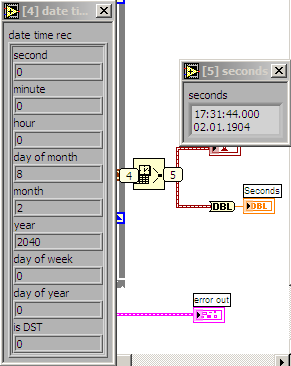- Subscribe to RSS Feed
- Mark Topic as New
- Mark Topic as Read
- Float this Topic for Current User
- Bookmark
- Subscribe
- Mute
- Printer Friendly Page
Date/Time <---> String
03-16-2006 09:10 AM
- Mark as New
- Bookmark
- Subscribe
- Mute
- Subscribe to RSS Feed
- Permalink
- Report to a Moderator
There's the Format Date/Time string function to convert from the timestamp
datatype to a string.
Now I'm searching for the reverse way to convert from that string back to
timestamp format again. Please tell me the function or a way I can do this
with as less effort as possible!
Thank you very much
Oliver Friedrich
03-16-2006 09:25 AM - edited 03-16-2006 09:25 AM
- Mark as New
- Bookmark
- Subscribe
- Mute
- Subscribe to RSS Feed
- Permalink
- Report to a Moderator
I would do that... 😉

Message Edité par TiTou le 03-16-200604:26 PM
We have two ears and one mouth so that we can listen twice as much as we speak.
Epictetus
03-16-2006 09:50 AM
- Mark as New
- Bookmark
- Subscribe
- Mute
- Subscribe to RSS Feed
- Permalink
- Report to a Moderator
___________________
Try to take over the world!
03-16-2006 09:56 AM
- Mark as New
- Bookmark
- Subscribe
- Mute
- Subscribe to RSS Feed
- Permalink
- Report to a Moderator
I'll add it to my vi box if you don't mind
We have two ears and one mouth so that we can listen twice as much as we speak.
Epictetus
03-16-2006 10:08 AM
- Mark as New
- Bookmark
- Subscribe
- Mute
- Subscribe to RSS Feed
- Permalink
- Report to a Moderator
___________________
Try to take over the world!
03-16-2006 10:29 AM - edited 03-16-2006 10:29 AM
- Mark as New
- Bookmark
- Subscribe
- Mute
- Subscribe to RSS Feed
- Permalink
- Report to a Moderator
After looking at the code I tried a "monkey test" putting silly dates.
For some reason the "date/time to seconds" :
- works fine until 19/01/2038...
- from 20/01/2038 to 06/02/2040 gives this :00:00:00.000 DD.MM.YYYY
- after 07/02/2040 seems to start back from : 17:31:44.000 01.01.1904

I think the "seconds" can lead to an explanation...
Message Edité par TiTou le 03-16-200605:30 PM
Message Edité par TiTou le 03-16-200605:33 PM
We have two ears and one mouth so that we can listen twice as much as we speak.
Epictetus
03-16-2006 10:49 AM
- Mark as New
- Bookmark
- Subscribe
- Mute
- Subscribe to RSS Feed
- Permalink
- Report to a Moderator
___________________
Try to take over the world!
03-17-2006 07:42 AM
- Mark as New
- Bookmark
- Subscribe
- Mute
- Subscribe to RSS Feed
- Permalink
- Report to a Moderator
If you need more information, let us know.
03-17-2006 08:18 AM
- Mark as New
- Bookmark
- Subscribe
- Mute
- Subscribe to RSS Feed
- Permalink
- Report to a Moderator
Actually, if I'm reading my calculator correctly, and allowing for it being a signed number, shouldn't that be about 275 billion years in each direction (and I realize I may be unnecessarily splitting hairs)? Anyway, I understood that this was already changed in 8, so that should be better.
And just to restate the point of the thread - we want a vi.lib String to Timestamp function!
___________________
Try to take over the world!
03-17-2006 08:19 AM - edited 03-17-2006 08:19 AM
- Mark as New
- Bookmark
- Subscribe
- Mute
- Subscribe to RSS Feed
- Permalink
- Report to a Moderator
That is simple but I don't like this kind of code because it may fail if the application is built and the FP stripped. It is also very slow because it runs in the user interface thread. Absolutely not convenient to convert hundreds of thousand timestamp. Anyway it shows that LabVIEW has already all the builtin functions to code a Time&Date string converter.
Message Edité par JeanPierre le 03-17-2006 09:19 AM
LabVIEW, C'est LabVIEW
